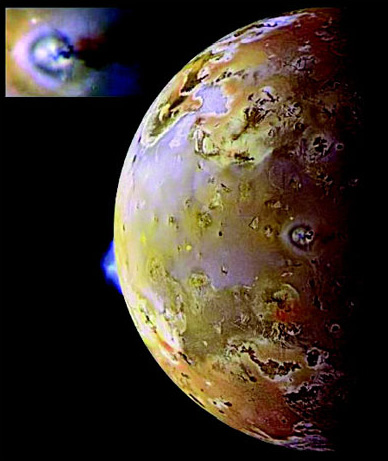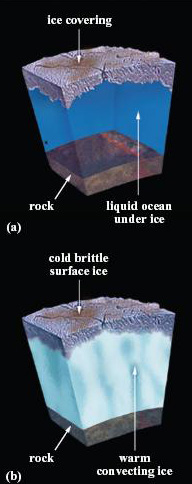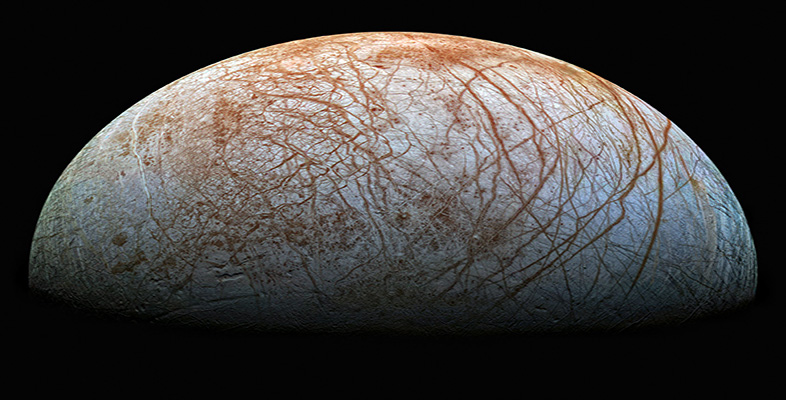1.4 The discovery of tidal heating
The Voyager fly-bys of the Jupiter system convinced planetary scientists that former preconceptions about 'dead' globes were wrong - even before Voyager 1 had got as far as Saturn, the mission had enabled them to identify a new heating mechanism to explain the discrepancies. The ease with which this revolution in thought was brought about was thanks to some of the Voyager images of Io, Jupiter's innermost Galilean satellite. Io is only a fraction larger and denser than the Moon, and so by rights Io should have been geologically quiet for the past 2-3 billion years. However, Io has a surface so young that (even with the more detailed images obtained subsequently) even the youngest impact craters have been erased and there are usually several volcanoes erupting simultaneously (Figure 12). Some of the eruptions are large enough to track using modern infrared telescopes in high-altitude observatories such as on the summit of Mauna Kea, Hawaii.

The above image was recorded on 28 June 1997 by the Galileo Orbiter, but it shows similar processes to those revealed 18 years previously by Voyager 1. The surface is dominated by lava flows, stained yellow and red by oxides of sulfur. An eruption plume can be seen rising 140 km above the limb (from a volcano named Pillan Patera), and a second eruption plume at the volcano Prometheus is seen from directly above near the centre of the disc. This is enlarged in the inset at the upper left. The bluish ring is the outline of the plume, which casts a reddish shadow onto the surface to its right. The black surface feature beneath the right-hand part of the plume is a lava flow that has erupted continually since 1979.
Most planetary scientists were staggered to find active volcanoes on Io, but not the authors of a paper that had been published in the journal Science just a few days before Voyager 1 arrived at Jupiter. In this paper, Stanton Peale and colleagues proposed that Io's interior should be largely molten because of heat generated by the tidal stressing experienced by Io as it orbits Jupiter. Although the degree of melting within Io remains open to debate, tidal heating (Box 2) was rapidly accepted as the power source for Io's volcanoes and for the episodes of resurfacing on the icy satellites.
Box 2: Tidal heating of satellites
When a major satellite is orbiting a giant planet, the tidal attraction of the planet distorts the shape of the satellite. This creates a tidal bulge centred on the side facing the planet and an equal bulge centred on the opposite face. The size of these bulges depends on the mass and proximity of the planet (tidal force is inversely proportional to the cube of the orbital radius), and on the strength of the material of which the satellite is made. In the extreme case of Io, the bulges are several kilometres high. Distortion of the globe associated with changes in location or size of the tidal bulges is what leads to tidal heating. The heat is generated by a kind of internal friction. This is the phenomenon that occurs if you take a bar of relatively weak metal and flex it backwards and forwards at a single point. The bent portion soon becomes hot to the touch. You can easily observe this for yourself if you are willing to sacrifice a wire coathanger to the cause of science.
If a satellite were to be rotating faster than its orbital period, the tidal bulges would have to migrate around the satellite in order to try to stay lined up with the planet. The continual distortion of the globe required for this to happen would generate an enormous amount of heat. Such a situation may have occurred very early in a satellite's life (or in the case of Triton, shortly after capture), but in most cases it would take tidal forces only a few million years to slow a satellite's rate of spin until it exactly matched its orbital period. This is why virtually all large satellites are now in synchronous rotation.
Tidal drag also tends to coax a satellite into an exactly circular orbit. This is the fate of any single satellite orbiting a sufficiently massive planet, and when it has been achieved the tidal stresses become constant and there is no more tidal heating. However, while a satellite's orbit is still elliptical then, even with synchronous rotation, there remain two reasons why the tidal stresses continue to vary, which allows tidal heating to continue.
In an elliptical orbit, the distance between planet and satellite is continually changing, and so the strength of the tidal force producing the tidal bulges varies accordingly. The bulges are slightly higher when the satellite is closer to the planet and lower when it is further away.
In an elliptical orbit, a satellite's speed varies with its distance from the planet (in accordance with Kepler's second law). However, the rate of the satellite's axial spin remains constant. Thus although for every orbit completed the satellite rotates exactly once, during the closest part of its orbit its rotation lags slightly behind its orbital motion, and during the furthest part of its orbit its rotation is slightly ahead of its orbital motion. Consequently, as seen from the planet, the satellite does not show exactly the same face throughout its orbit, rather it swings slightly from side to side. The tidal bulges are raised by forces acting directly on a line through the centres of the two bodies, and so their locations oscillate east and west across the satellite's surface.
So, for a satellite in an elliptical orbit, both the continual variation in the heights and the oscillation in the locations of the bulges deform the satellite's interior, and so cause heating. The reason why none of the orbits of the satellites of the giant planets has yet become exactly circular is that every satellite has neighbours. Mutual perturbations each time an inner satellite overtakes an outer (and therefore slower) satellite keep the orbits slightly elliptical, despite the tidal force from the planet.
This effect is magnified when satellites are in a situation of orbital resonance, i.e. where the orbital periods of satellites in adjacent orbits are simple ratios. This is particularly strong among the three inner Galilean satellites: Europa completes exactly one orbit for every two orbits by Io, and Ganymede in turn has exactly twice the orbital period of Europa. The resulting exaggerated eccentricity of the orbits, described as forced eccentricity, is slight (0.04 in the case of Io and 0.01 for Europa), but sufficient to power Io's volcanoes and the young (probably continuing) activity on Europa. It also explains why Ganymede shows plenty of signs of past geological activity, whereas Callisto shows few or no signs. (Although three times Callisto's orbital period is almost exactly seven times Ganymede's orbital period, this 7:3 orbital resonance does not lead to sufficient forced eccentricity of Callisto's orbit to lead to tidal heating, especially as Callisto is relatively far from Jupiter.)
Of the icy satellites, Europa (see Figure 11a in Section 1.3) has the youngest icy surface certainly in the Jupiter system and probably in the entire outer Solar System. Density models, supported now by more specific observations, suggest that Europa has about 100 km of icy material overlying a rocky interior. The rate of tidal heating within Europa must be less than in Io, because Europa is further from Jupiter and has a less eccentric orbit. So, after the Voyager encounters, Europa became regarded as the ice-covered equivalent of a less-active version of Io. Certainly this could explain the fracturing and resurfacing evident on Europa's surface, and speculation abounded as to whether the rate of heat transfer from the rocky part into the base of the ice would be sufficient to maintain an unfrozen ocean sandwiched between the ice and the rock. Essentially, the issue depends on which of the two alternative models in Figure 13 is correct. Europa and its possible ocean are the main focus of the bulk of this course.

The famous science fiction author Arthur C. Clarke was one of the first to realise the astrobiological implications of a tidally heated Europa, by analogy with communities around 'black smoker' hydrothermal vents on the Earth's ocean floor. In 2010: Odyssey Two (published in 1982 as a sequel to the more famous 2001: A Space Odyssey) he imagined an explorer's findings on the floor of the Europan ocean:
…the first oasis filled him with delighted surprise. It extended for almost a kilometre around a tangled mass of pipes and chimneys deposited from mineral brines gushing from the interior. Out of that natural parody of a Gothic castle, black, scalding liquids pulsed in a slow rhythm, as if driven by the beating of some mighty heart. And, like blood, they were the authentic sign of life.
The boiling fluids drove back the deadly cold leaking down from above, and formed an island of warmth on the seabed. Equally important, they brought from Europa's interior all the chemicals of life. There, in an environment where none had expected it, were energy and food, in abundance…
In the tropical zone close to the contorted walls of the 'castle' were delicate, spidery structures that seemed to be the analogy of plants, though almost all were capable of movement. Crawling among these were bizarre slugs and worms, some feeding on the plants, others obtaining their food directly from the mineral-laden waters around them. At greater distances from the source of heat - the submarine fire around which all the creatures warmed themselves - were sturdier, more robust organisms, not unlike crabs or spiders.
Armies of biologists could have spent lifetimes studying that one small oasis.
(Clarke, 1982)
It took several years for speculations such as Clarke's to become acceptable among mainstream scientists. One reason for this is that ocean-floor hydrothermal vents had not yet been recognised as one of the most likely environments where life on Earth could have originated. Another reason is that the Voyager indications of an ocean below Europa's ice were not nearly so compelling as the evidence that has become available subsequently. However, by the late 1990s NASA was presenting Europa's astrobiological potential as the main reason why the US Senate ought to provide funding for a dedicated Europa mission, and both NASA and ESA are considering Europa missions that may launch by 2020.
Question 2
Using the orbital radii given in Table 1 (see Section 1.1), calculate the tidal force of Jupiter on Europa as a proportion of the tidal force of Jupiter on Io.
Answer
Box 2 states that tidal force is inversely proportional to the cube of the orbital radius. Thus (tidal force on Europa)/(tidal force on Io) = (Io orbital radius)3/(Europa orbital radius)3 = 421.63/670.93 = 0.249. Thus the tidal force on Europa is a quarter that on Io. (Note: the amount of tidal heating as a result of this force depends on other factors such as the amount of forced eccentricity and the body's internal properties.)
